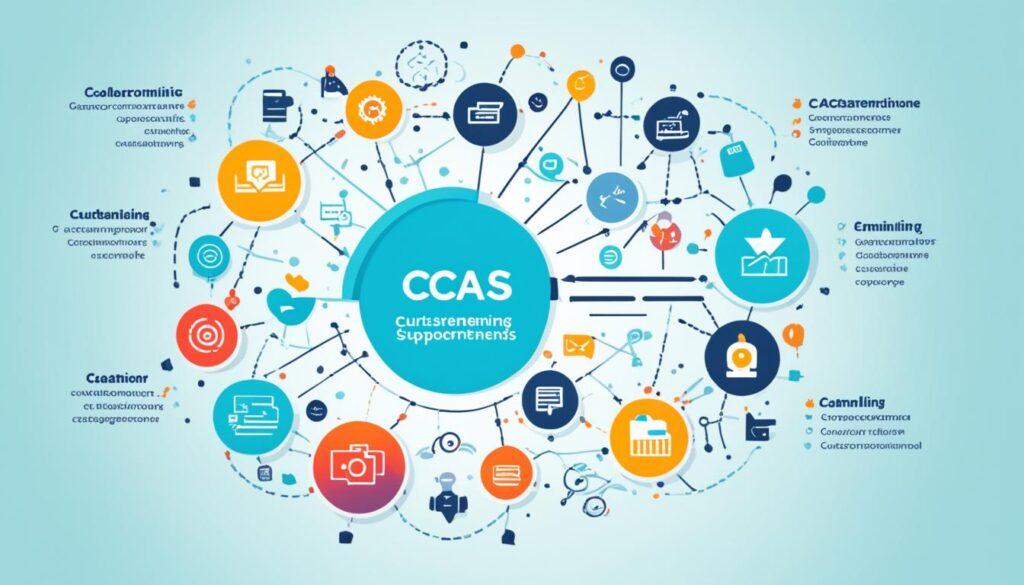Welcome to our article on optimizing customer support with the top customer service tools. In today’s fast-paced business landscape, providing exceptional customer experiences is vital for your organization’s success. By leveraging the right customer service tools, you can enhance customer satisfaction, streamline support processes, and drive brand loyalty.
Customer service tools encompass a range of software and technologies designed to improve customer interactions and support operations. From customer support software to customer service management platforms, these tools play a crucial role in optimizing your customer experience. Let’s explore some of the top tools that can take your customer support to the next level.
One of the essential customer service tools is chatbots. These AI-powered virtual assistants offer immediate assistance and can handle routine customer inquiries, freeing up your support agents to focus on more complex issues. Virtual and augmented reality (VR/AR) technologies are also transforming customer interactions, providing immersive experiences and innovative solutions.
CRM systems and CXM systems are critical for managing customer relationships and collecting feedback from multiple touchpoints. Email marketing software enables personalized communication with your customers, while speech analytics helps uncover essential insights from customer conversations.
Self-service portals empower customers to find answers to their questions independently, reducing support queues and improving customer satisfaction. Additionally, customer data platforms (CDPs) allow you to gather and analyze customer data from various sources, enabling you to deliver more personalized experiences and anticipate customer needs.
Another essential tool is Contact Center as a Service (CCaaS), which provides a cloud-based contact center solution. It offers scalability, cost-effectiveness, and allows you to leverage advanced technologies without significant infrastructure investments. Marketing automation software streamlines your marketing campaigns and helps deliver targeted messages to your customers.
Messaging channels, such as Facebook Messenger and Instagram DMs, are gaining popularity for customer service. To deliver high-quality support via messaging, it’s essential to understand the unique characteristics of these channels and tailor your communication accordingly.
In the upcoming sections, we will delve deeper into the importance of optimizing customer experiences and explore each of these customer service tools in detail. Stay tuned to learn how you can elevate your support and create exceptional customer experiences using these tools.
The Importance of Optimizing Customer Experiences
Optimizing customer experiences is essential for any organization. It drives customer satisfaction, brand reach, revenue, and reduces churn.
By providing a meaningful and consistent customer experience, organizations can increase customer satisfaction scores, revenue, and profits. Optimized customer experiences encourage customers to stay with a brand and not switch to competitors. This leads to long-term customer loyalty and increased customer lifetime value.
Creating an exceptional customer experience encompasses every interaction a customer has with a brand, from the first interaction to post-purchase support. It involves understanding customer needs and expectations and delivering personalized, seamless experiences across all touchpoints.
A study conducted by Deloitte found that organizations that prioritize customer experience have higher customer loyalty rates and increased revenue growth compared to their competitors. In fact, 60% of customers are willing to pay more for a better customer experience.
To optimize customer experiences, organizations need to:
- Understand customer journeys and pain points
- Implement customer feedback mechanisms
- Train and empower employees to deliver exceptional service
- Use data and analytics to personalize interactions
- Embrace technology and automation
By focusing on these strategies, organizations can create loyal customers who become brand advocates, driving organic growth and expanding the brand’s reach in the market.
Implications of Optimized Customer Experiences
“Investing in optimizing customer experiences is not just a matter of good service, but a strategic decision that impacts the financial health and sustainability of a business. By prioritizing customer satisfaction and loyalty, organizations can boost revenue, reduce churn, and gain a competitive edge in the market.”
Case Study: Optimizing Customer Experience at XYZ Corporation
XYZ Corporation, a leading e-commerce company, recognized the importance of optimizing customer experiences to stay ahead in a highly competitive market. By implementing a customer-centric approach, XYZ Corporation witnessed a significant increase in customer satisfaction scores and brand reach.
Through personalized recommendations, streamlined checkout processes, and efficient post-purchase support, XYZ Corporation improved customer retention and reduced churn. This resulted in a 25% increase in revenue within the first year of implementing optimized customer experiences.
Infographic: The Impact of Optimized Customer Experiences

Top Customer Service Tools for Optimizing CX
When it comes to optimizing customer experience, businesses have a wide range of tools at their disposal. These tools play a vital role in enhancing customer interactions, managing relationships, and gaining valuable insights. Let’s explore some of the top customer service tools that can take your customer experience to the next level.
1. Chatbots
Chatbots have revolutionized the way businesses interact with their customers. Powered by AI, chatbots provide immediate assistance, answer FAQs, and handle basic customer inquiries. With their round-the-clock availability, chatbots ensure customers receive quick and accurate responses, improving satisfaction levels and reducing response times.
By implementing chatbots, businesses can free up their support teams to focus on more complex issues while still delivering efficient and personalized customer service.
2. VR/AR
Virtual Reality (VR) and Augmented Reality (AR) technologies are not only transforming the gaming and entertainment industries but also revolutionizing customer interactions. By incorporating VR and AR into the customer experience, businesses can provide immersive and interactive experiences that captivate customers.
For example, VR can be used to offer virtual tours of properties or showcase products in a virtual showroom, while AR can enhance the in-store shopping experience by overlaying digital information on physical products. These technologies not only engage customers but also enable them to make more informed purchasing decisions.
3. CRM Systems
A Customer Relationship Management (CRM) system is a powerful tool for managing customer data, interactions, and relationships. CRM systems enable businesses to track customer interactions across multiple touchpoints and create a unified view of each customer.
By leveraging CRM systems, businesses can gain deeper insights into customer preferences, behaviors, and pain points. This allows for more personalized interactions, targeted marketing campaigns, and proactive customer service.
4. CXM Systems
Customer Experience Management (CXM) systems focus on collecting and analyzing customer feedback from various channels and touchpoints. These systems provide businesses with a holistic view of the customer journey, allowing them to identify areas for improvement, track customer sentiment, and make data-driven decisions.
By leveraging CXM systems, businesses can uncover valuable insights about customer preferences, pain points, and expectations. This valuable information can be used to enhance the overall customer experience and drive customer loyalty.
5. Email Marketing Software
Email marketing is a powerful tool for delivering personalized messages to customers and nurturing relationships. Email marketing software enables businesses to segment their customer base, create targeted campaigns, and automate email workflows.
By using email marketing software effectively, businesses can deliver relevant content to customers, keeping them engaged and informed. It also helps to drive customer retention and stimulate repeat purchases.
6. Speech Analytics
Speech analytics is a valuable tool for understanding customer sentiments, emotions, and drivers. By analyzing customer interactions, speech analytics software can identify trends, detect customer frustrations, and highlight areas for improvement.
With speech analytics, businesses can fine-tune their customer service strategies, identify training needs, and make data-driven decisions. This empowers businesses to deliver a superior customer experience and build strong customer relationships.
Comparison of Top Customer Service Tools
| Tools | Key Features |
|---|---|
| Chatbots | AI-powered virtual assistants for immediate customer assistance |
| VR/AR | Immersive and interactive experiences for customers |
| CRM Systems | Centralized customer data management and relationship tracking |
| CXM Systems | Collecting and analyzing customer feedback for holistic insights |
| Email Marketing Software | Personalized messaging and automated email campaigns |
| Speech Analytics | Identifying customer sentiments, emotions, and trends |
As customer expectations continue to evolve, businesses must leverage the right tools to optimize their customer experience. Whether it’s deploying chatbots for immediate assistance, incorporating VR/AR for immersive interactions, or implementing CRM and CXM systems for data-driven insights, these customer service tools are essential for delivering exceptional customer experiences.

Enhancing Support with Self-Service Portals and CDPs
Self-service portals and customer data platforms (CDPs) are valuable tools for enhancing customer support. These tools empower customers to find solutions on their own and allow businesses to leverage customer data effectively. Let’s explore how self-service portals and CDPs can optimize your customer support strategy.
Self-Service Portals: Empowering Customers
Self-service portals provide customers with easy access to knowledge bases, forums, and tools. By allowing customers to help themselves, these portals reduce the workload on support teams and improve customer satisfaction. With self-service portals, customers can find answers to their questions quickly and efficiently, without the need to contact a support agent. This not only saves time for both parties but also empowers customers to take control of their own support experience.
Some key benefits of self-service portals include:
- 24/7 access to support resources
- Reduced wait times for assistance
- Improved customer satisfaction
- Cost savings for businesses
Self-service portals provide customers with the tools and resources they need to resolve issues independently. By enabling customers to find answers on their own, businesses can deliver a more efficient and satisfying support experience.
Customer Data Platforms: Leveraging Insights
Customer data platforms (CDPs) collect and consolidate data from various sources, such as CRM systems, customer interactions, and website analytics. By centralizing customer data, CDPs provide businesses with a comprehensive consumer profile. This data can be utilized to predict customer behavior, drive personalization efforts, and improve data-driven tasks.
Key benefits of using a CDP include:
- 360-degree view of the customer
- Enhanced personalization and segmentation
- Improved customer targeting and acquisition
- Effective customization of marketing campaigns
A customer data platform enables businesses to harness the power of customer data, unlocking valuable insights and enabling personalized experiences that drive customer satisfaction and loyalty.
Combining Self-Service Portals and CDPs for Optimal Support
When self-service portals and CDPs are integrated, businesses can provide a seamless support experience that addresses customer needs proactively. By leveraging customer data from the CDP, self-service portals can deliver personalized content and recommendations to customers, enhancing their satisfaction and increasing the likelihood of issue resolution without agent intervention.
For example, when a customer visits a self-service portal, the portal can use the customer’s previous interactions, preferences, and purchase history stored in the CDP to suggest relevant articles or resources. This level of personalization not only improves the customer experience but also increases the effectiveness of self-service support options.
Additionally, the data collected through self-service interactions can be fed back into the CDP, providing further insights into customer behavior and preferences. This data can then be used to refine marketing campaigns, identify pain points in the customer journey, and drive continuous improvement in customer support strategies.
By combining self-service portals and CDPs, businesses can create a support ecosystem that empowers customers, optimizes resources, and drives customer satisfaction and loyalty.

| Benefits of Self-Service Portals | Benefits of Customer Data Platforms (CDPs) |
|---|---|
| 24/7 access to support resources | 360-degree view of the customer |
| Reduced wait times for assistance | Enhanced personalization and segmentation |
| Improved customer satisfaction | Improved customer targeting and acquisition |
| Cost savings for businesses | Effective customization of marketing campaigns |
Leveraging CCaaS and Marketing Automation
Leveraging the power of Contact Center as a Service (CCaaS) and marketing automation software can significantly enhance your customer service and marketing efforts. CCaaS is a cloud-based solution that allows businesses to tap into contact center software provided by a service provider. By adopting CCaaS, you can streamline your customer service operations, reduce costs, and quickly adapt to new communication technologies.
With CCaaS, there is no need to invest in hardware or expensive infrastructure. The service provider takes care of the hardware maintenance and software updates, allowing you to focus on providing excellent customer support. This cloud-based solution also offers the flexibility to scale your contact center operations up or down, depending on your business needs.
To further optimize your customer interactions, marketing automation software is an invaluable tool. This software enables you to send targeted messages to your customers based on their demographics, interests, and purchase history. By automating your marketing campaigns, you can deliver personalized content to your customers at the right time, increasing engagement and conversion rates.
Marketing automation software not only saves you time and effort but also helps you analyze your marketing performance. You can track key metrics such as email open rates, click-through rates, and conversion rates, allowing you to refine your marketing strategies and achieve better results. By freeing up your customer service representatives from repetitive marketing tasks, they can focus on providing exceptional support and building stronger customer relationships.
By leveraging CCaaS and marketing automation software, you can revolutionize your customer service and marketing processes, ensuring a seamless and personalized experience for your customers. The combination of efficient contact center operations and targeted marketing campaigns will empower your business to deliver exceptional service and drive customer loyalty and satisfaction.
Enhance your customer service and marketing capabilities with CCaaS and marketing automation software today!
Key Benefits of CCaaS:
- Cloud-based solution, reducing costs and capital expenses
- Easily adapt to new communication technologies
- Scalable to meet your business needs
- No hardware or infrastructure maintenance required
Key Benefits of Marketing Automation Software:
- Targeted messaging based on customer demographics and purchase history
- Automated marketing campaigns for personalized customer interactions
- Time and effort savings for customer service representatives
- Analysis of marketing performance for better results
| CCaaS | Marketing Automation Software |
|---|---|
| Reduces costs and capital expenses | Enables targeted messaging based on customer data |
| Flexibility to embrace new technologies | Automates marketing campaigns for efficiency |
| Scalable to meet changing business demands | Provides insights through performance tracking |
| No hardware maintenance required | Frees up time for customer service reps |

Delivering High-Quality Support via Messaging Channels
Messaging channels, such as Facebook Messenger and Instagram DMs, have gained significant popularity as channels for customer service. To provide high-quality support via messaging, it is crucial for businesses to understand the unique characteristics of these channels.
Customers on messaging platforms are often using mobile devices and prefer brief and concise language. They expect faster responses compared to traditional channels. Therefore, it is important for customer support teams to adapt their communication style accordingly.
One way to deliver high-quality support via messaging is to integrate messaging communications into existing customer data. This allows support teams to have a holistic view of each customer and provide more personalized assistance. Additionally, it is essential for support representatives to be less formal and more conversational in their interactions, creating a friendly and approachable atmosphere.
While messaging channels offer numerous benefits, there may be situations where the conversation becomes too complex or time-bound. In such cases, it is crucial to know when to switch to another channel, such as email or phone support, to ensure a seamless customer experience.
FAQ
What is customer experience optimization?
Customer experience optimization involves creating meaningful and valuable interactions between customers and organizations to enhance customer satisfaction and loyalty.
Why is optimizing customer experiences important?
Optimizing customer experiences increases brand reach, conversations with customers, and their lifetime value. It drives customer satisfaction, revenue, and reduces churn.
What are the top customer service tools for optimizing customer experience?
The top customer service tools for optimizing customer experience include chatbots, VR/AR, CRM systems, CXM systems, email marketing software, speech analytics, self-service portals, customer data platforms, CCaaS, and marketing automation software.
How do self-service portals and customer data platforms enhance customer support?
Self-service portals allow customers to help themselves by accessing knowledge bases, forums, and tools, reducing the workload on support teams. Customer data platforms collect and consolidate customer data from various sources, providing a comprehensive consumer profile for improved personalization and data-driven tasks.
What is CCaaS and how does it help businesses?
CCaaS, or Contact Center as a Service, is a cloud-based solution that allows businesses to use contact center software provided by a service provider. CCaaS reduces costs, capital expenses, and enables businesses to quickly embrace new technologies.
How can businesses deliver high-quality support via messaging channels?
To deliver high-quality support via messaging channels, businesses should understand the unique characteristics of messaging channels and integrate messaging communications into existing customer data. Support teams should be less formal and more conversational in their interactions.
